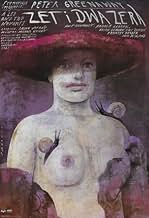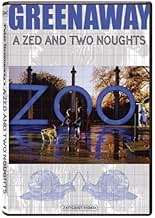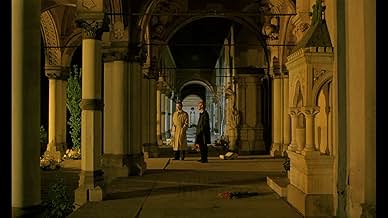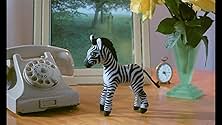CALIFICACIÓN DE IMDb
7.2/10
8 k
TU CALIFICACIÓN
Los zoólogos gemelos pierden a sus esposas en un accidente automovilístico y se obsesionan con los animales en descomposición.Los zoólogos gemelos pierden a sus esposas en un accidente automovilístico y se obsesionan con los animales en descomposición.Los zoólogos gemelos pierden a sus esposas en un accidente automovilístico y se obsesionan con los animales en descomposición.
- Dirección
- Guionistas
- Elenco
- Dirección
- Guionistas
- Todo el elenco y el equipo
- Producción, taquilla y más en IMDbPro
Opiniones destacadas
For better or for worse, A Zed & Two Noughts is a very unusual film. This is hardly surprising given that it was directed by the avant-gardist director Peter Greenaway. It begins with a car accident at a zoo, where two women are killed when their vehicle collides with a pregnant swan. These women are twins who were in turn married to a couple of twin zoologists, Oliver and Oswald Deuce. Shortly afterwards these men start simultaneous affairs with the survivor of the accident, the driver Alba Bewick who lost a leg as a result of the crash. She later has the other one removed surgically for symmetrical reasons and falls pregnant to the twins.
This strange film features both the good and the bad typical of Greenaway. The good is the visual presentation and distinctive bizarre qualities, the bad is more or less any time someone opens their mouths, which unfortunately is quite often. Greenaway is really terrible at writing dialogue. His script constantly tries to be clever, which is not the same thing as actually being clever. Needless to say, the dialogue is painful to listen to and ultimately makes the film hard work and not in a good way. But setting this aside, amongst other things, it's an intriguing concoction about symmetry, birth and decay. Of the latter are several time-lapse films showing a variety of animals and organic matter decaying - films which were fascinating and repulsive in equal measure. We also have excellent cinematography from Greenaway's common collaborator Sacha Vierney, with many shots being a joy to behold. The other significant cog in the wheel is the typically persistent minimalist score from Michael Nyman, which is sometimes brilliant even if it does border on irritating at others. We also have the most unexpected collaborator in any Greenaway film - none other than Jim 'Nick Nick' Davidson, the politically incorrect stand-up comedian who appears as a zoo-keeper.
In summary, A Zed & Two Noughts was an interesting film spoiled by Greenaway's horrible dialogue and awful characters. If you can get beyond those it does offer some fascinating stuff but you sure have got your work cut out with this one.
This strange film features both the good and the bad typical of Greenaway. The good is the visual presentation and distinctive bizarre qualities, the bad is more or less any time someone opens their mouths, which unfortunately is quite often. Greenaway is really terrible at writing dialogue. His script constantly tries to be clever, which is not the same thing as actually being clever. Needless to say, the dialogue is painful to listen to and ultimately makes the film hard work and not in a good way. But setting this aside, amongst other things, it's an intriguing concoction about symmetry, birth and decay. Of the latter are several time-lapse films showing a variety of animals and organic matter decaying - films which were fascinating and repulsive in equal measure. We also have excellent cinematography from Greenaway's common collaborator Sacha Vierney, with many shots being a joy to behold. The other significant cog in the wheel is the typically persistent minimalist score from Michael Nyman, which is sometimes brilliant even if it does border on irritating at others. We also have the most unexpected collaborator in any Greenaway film - none other than Jim 'Nick Nick' Davidson, the politically incorrect stand-up comedian who appears as a zoo-keeper.
In summary, A Zed & Two Noughts was an interesting film spoiled by Greenaway's horrible dialogue and awful characters. If you can get beyond those it does offer some fascinating stuff but you sure have got your work cut out with this one.
Greenaway's obsessions with lists, wordplay, coincidence, sexuality, the surreal, and the explicit (not to mention the "conventionally used" ones like men and women, birth and eating and death, physiology (formal and psychological), and abstraction) come to a head in this film. A bizarre mileau of fancy digressions and focused narrativity create a film which is perhaps too obtuse for first time viewers but is, as far as I'm concerned, the best way to initiate oneself into the "world" of Greenaway.
Peter Greenaway is arty. Painfully so. However he readily admits that this film is "self-conscious", "manufactured" and he says that all cinema is probably as "artificial" a form as you can get.
This film is beautiful to look at. Greenaway was inspired, visually, by paintings of the mid 17th century, particularly those of Vermeer. Almost every shot is composed like a painting. Many of the shots are symmetrical, walls are filmed flat so that the horizontal lines are parallel with the top and bottom of the frame. Objects are placed on tables as if subjects for a still life. Lighting is used in an alternation of light, shade,light,shade receding to the back of the picture, which is a signature of the type of 17th century, Western art that Greenaway is paying homage to.
The substance of the film follows weighty themes, all of which are explained in great detail through the director's commentary: evolution, light and twin-ship.
What is lacking is emotion. This is a cerebral film. Your emotional reaction to it will be through the imagery, be it beautiful or repulsive. You will not engage with the characters on an emotional level. You'll find them hard to relate to. The performances are stilted and amateur theatrical. It is fortunate, then, that Michael Nyman provides a fantastic score (present on almost every scene and almost outstaying its welcome) which prevents the dialogue (the script leaves a lot to be desired too) rendering everything flat.
Rent this if you enjoy visuals for their own sake, if you wear spectacles and if you like holding your chin in your hand and frowning. I qualify on all those points, so I enjoyed it a great deal.
Extra points for an extraordinarily thorough director's commentary on the DVD which serves to pull out all the hidden depths. Though one could make the point that an explanation that adds so much extra understanding leaves you feeling that the film failed adequately to convey much of what was intended.
DVD easter eggs (worth seeing): http://www.dvd.net.au/hidden.cgi?movie_id=10484
This film is beautiful to look at. Greenaway was inspired, visually, by paintings of the mid 17th century, particularly those of Vermeer. Almost every shot is composed like a painting. Many of the shots are symmetrical, walls are filmed flat so that the horizontal lines are parallel with the top and bottom of the frame. Objects are placed on tables as if subjects for a still life. Lighting is used in an alternation of light, shade,light,shade receding to the back of the picture, which is a signature of the type of 17th century, Western art that Greenaway is paying homage to.
The substance of the film follows weighty themes, all of which are explained in great detail through the director's commentary: evolution, light and twin-ship.
What is lacking is emotion. This is a cerebral film. Your emotional reaction to it will be through the imagery, be it beautiful or repulsive. You will not engage with the characters on an emotional level. You'll find them hard to relate to. The performances are stilted and amateur theatrical. It is fortunate, then, that Michael Nyman provides a fantastic score (present on almost every scene and almost outstaying its welcome) which prevents the dialogue (the script leaves a lot to be desired too) rendering everything flat.
Rent this if you enjoy visuals for their own sake, if you wear spectacles and if you like holding your chin in your hand and frowning. I qualify on all those points, so I enjoyed it a great deal.
Extra points for an extraordinarily thorough director's commentary on the DVD which serves to pull out all the hidden depths. Though one could make the point that an explanation that adds so much extra understanding leaves you feeling that the film failed adequately to convey much of what was intended.
DVD easter eggs (worth seeing): http://www.dvd.net.au/hidden.cgi?movie_id=10484
A rewarding post modern film about life and decay and the effects of a single moment on a person's life. Great sets and photography by the legendary cinematographer Sacha Vierny, this film makes you ultra aware that you are watching a film, or a sort of theatrical filmed piece. Greenaway is an aquired but very rewarding taste, and no other director makes films as he does. A disturbing somber film for serious fans of modern cinema. Greenaway is a must in your education of film.
This fine film is written in an intelligent, multilayered way of such a degree and quality as I have only seen in top-notch theatre. Greenaway delivers a dark but intoxicating tale of decay, evolution and the crucial importance of symmetry.
The themes of this film emerge not only through Greenaway's script, but also through the images produced by his tight, clear directing. The choice of images and ability to linger on single shots suggests a creative mind as focused and obsessed as the characters he portrays.
As with many of Greenaway's works, this certainly isn't a film for anyone wanting a cheap thrill and easy satisfaction. Its particularly dark humour and images of accelerated decay and death are more likely to please those who prefer to view film as a medium of art than those seeking mere entertainment.
It is a very long time since a film has impressed me quite as much as this.
The themes of this film emerge not only through Greenaway's script, but also through the images produced by his tight, clear directing. The choice of images and ability to linger on single shots suggests a creative mind as focused and obsessed as the characters he portrays.
As with many of Greenaway's works, this certainly isn't a film for anyone wanting a cheap thrill and easy satisfaction. Its particularly dark humour and images of accelerated decay and death are more likely to please those who prefer to view film as a medium of art than those seeking mere entertainment.
It is a very long time since a film has impressed me quite as much as this.
¿Sabías que…?
- TriviaThis film was Peter Greenaway's first collaboration with cinematographer Sacha Vierny, who went on to shoot virtually all of Greenaway's work in the 1980s and 1990s, until Vierny's death in 2001. Greenaway referred to Vierny as his "most important collaborator".
- Citas
Alba Bewick: In the land of the legless the one-legged woman is queen.
- ConexionesFeatured in Peter Greenaway (1992)
- Bandas sonorasThe Teddy Bears' Picnic
Music by John W. Bratton
Lyrics by Jimmy Kennedy
Performed by The BBC Dance Orchestra
Directed by Henry Hall
Courtesy of EMI MUSIC PUBLISHING LTD and EMI RECORDS LTD
Also sung by Venus De Milo (Frances Barber)
Selecciones populares
Inicia sesión para calificar y agrega a la lista de videos para obtener recomendaciones personalizadas
- How long is A Zed & Two Noughts?Con tecnología de Alexa
Detalles
- Fecha de lanzamiento
- Países de origen
- Idiomas
- También se conoce como
- A Zed & Two Noughts
- Locaciones de filmación
- Productoras
- Ver más créditos de la compañía en IMDbPro
Contribuir a esta página
Sugiere una edición o agrega el contenido que falta





























